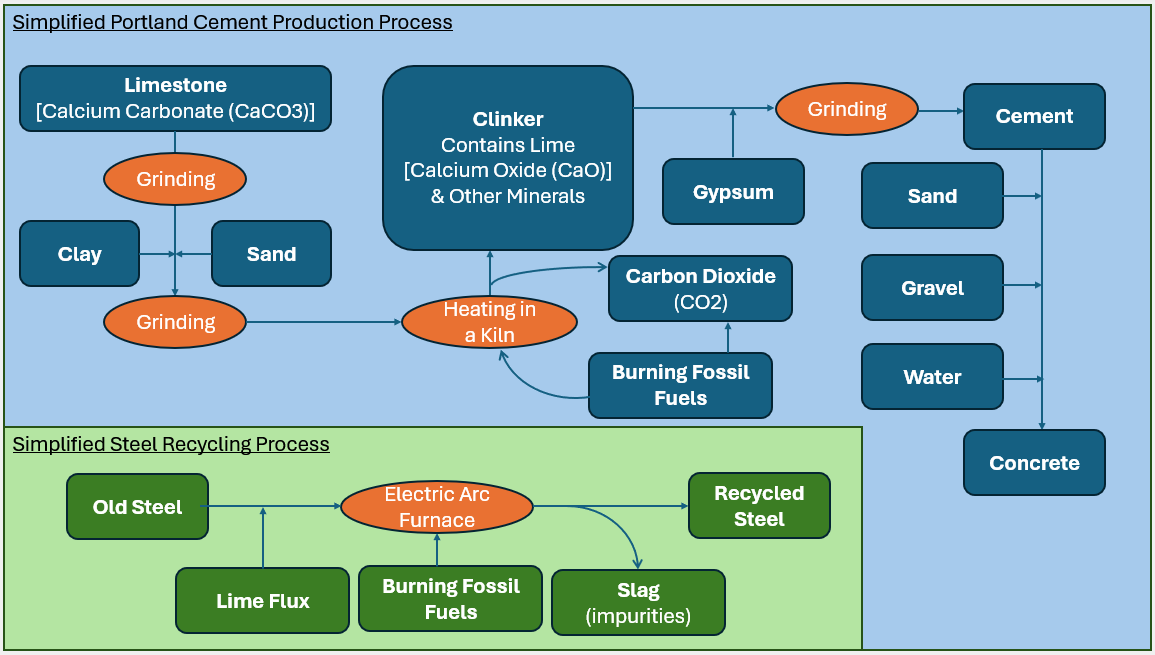Is “Electric Cement” the answer to low-carbon Concrete?
The first thing to understand about concrete, is that the world uses a staggering amount of it, enough to cover the entirety of England every year.
To produce all that concrete, we currently use a multi-stage process that takes limestone from a quarry through multiple stages of grinding, heating, and adding of other materials, until we can pour concrete to make a foundation or building.
Along the way vast amounts of CO2 is emitted, both from high-temperature heating processes and by the chemical reactions involved, the basic one being the breakdown of limestone (CaCO3) into lime (CaO), the byproduct of which is Carbon Dioxide (CO2). A lot of CO2 is emitted by this process, around 3% of the world’s CO2 emissions in fact, more than the entire continent of South America.
So it’s a crucial sector to decarbonise, but because of the very nature of the chemical reactions it has always seemed like one of the hardest nuts to crack, but that is rapidly changing.
A team of researchers from Cambridge University think they may have cracked it, by developing a method to recycle concrete using electrically powered steel furnaces, decarbonising both concrete and steel production at the same time.
To understand how this works and how it solves a few major problems, we have to dive into how concrete is produced today, and if you are, like me, not overly familiar with the difference between limestone & lime or clinker & slag, I’ve made the following flowchart:
As we can see CO2 is made both in the production of clinker and in the production of the heat needed to power the kilns (normally burning coal). Efforts to decarbonise this process have to tackle both areas, producing heat using low-carbon power, and reducing or replacing the clinker.
Initial efforts have been to reduce the amount of clinker used in the final cement mix, and to use low-carbon sources to power the kilns. Carbon Capture could be a solution, and new building codes could help nudge the industry in the right direction, but fundamental changes to the process are required to get us all the way to zero emissions.
Some companies, like Sublime Systems based in the US, claim to be able to skip both processes by isolating lime (CaO) from raw materials using low-carbon electricity and an electrochemical reaction. In theory this could get us to zero emission cement, but they need to prove their final product performs as well as current cements, it will be very interesting to watch how they attempt to scale up their process and commercialise it, but it shows some real promise.
And then we come to the Cambridge Researchers. They have upended the flowchart, by taking old concrete, breaking it back down into cement (not usable at this point as it is missing some key chemicals) then adding that cement to an electric arc furnace used for steel manufacturing. Through the various chemical reactions that happen in that furnace they can produce a product (which they call Electric Cement) that is essentially recycled cement, ready to be shipped to a construction site and turned into concrete again.
This seems to hit three birds with one stone, no CO2 emissions from powering a kiln, no CO2 emissions from limestone becoming lime, and reducing the waste material from the steel recycling process.
It could be a really fantastic breakthrough with the potential to scale up and help decarbonise one of the trickiest sectors of our economy. We will watch with interest.
Further Reading
The full article in Nature: Electric recycling of Portland cement at scale
Annual CO2 Emisions from Cement: Our World in Data
Further Listening
Volts Podcast - We are closing in on zero carbon cement
Thumbnail Photo by Saad Salim on Unsplash



